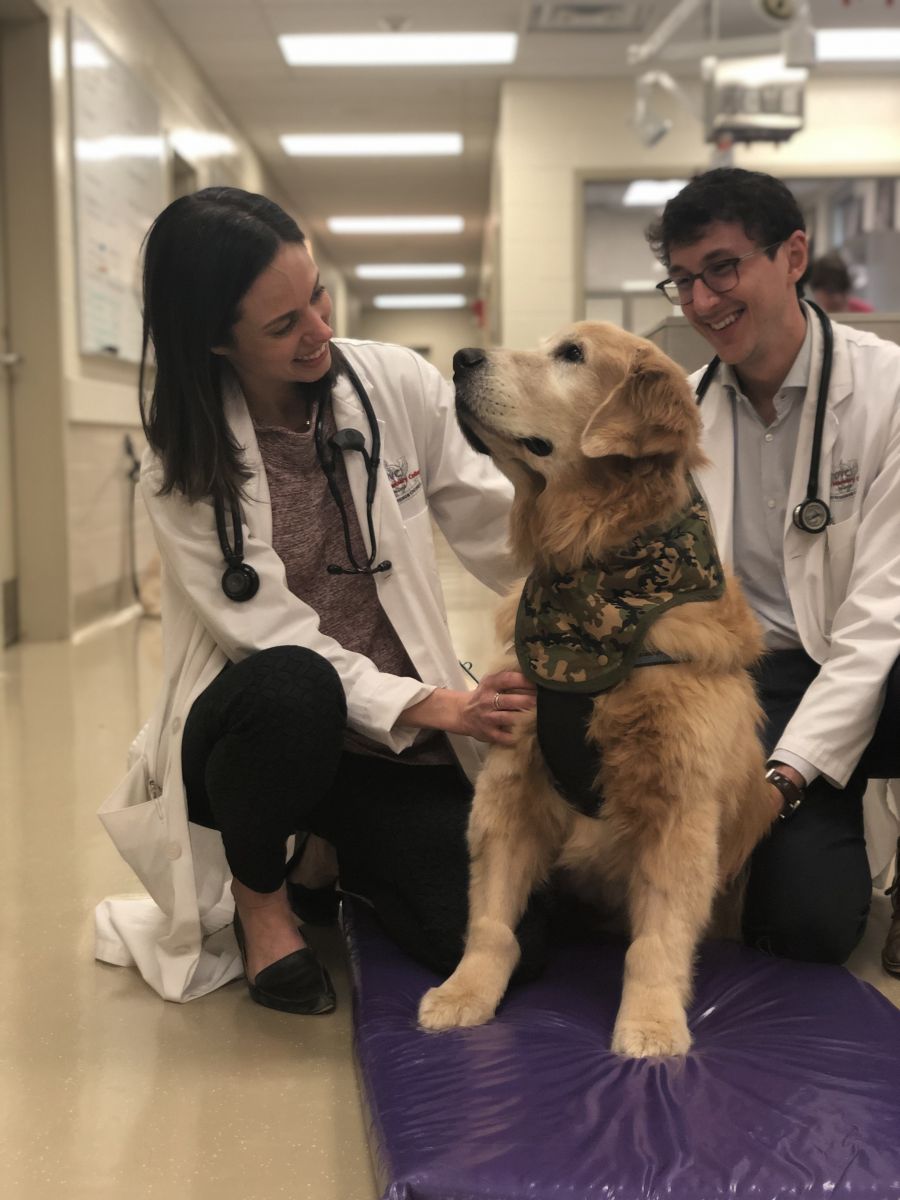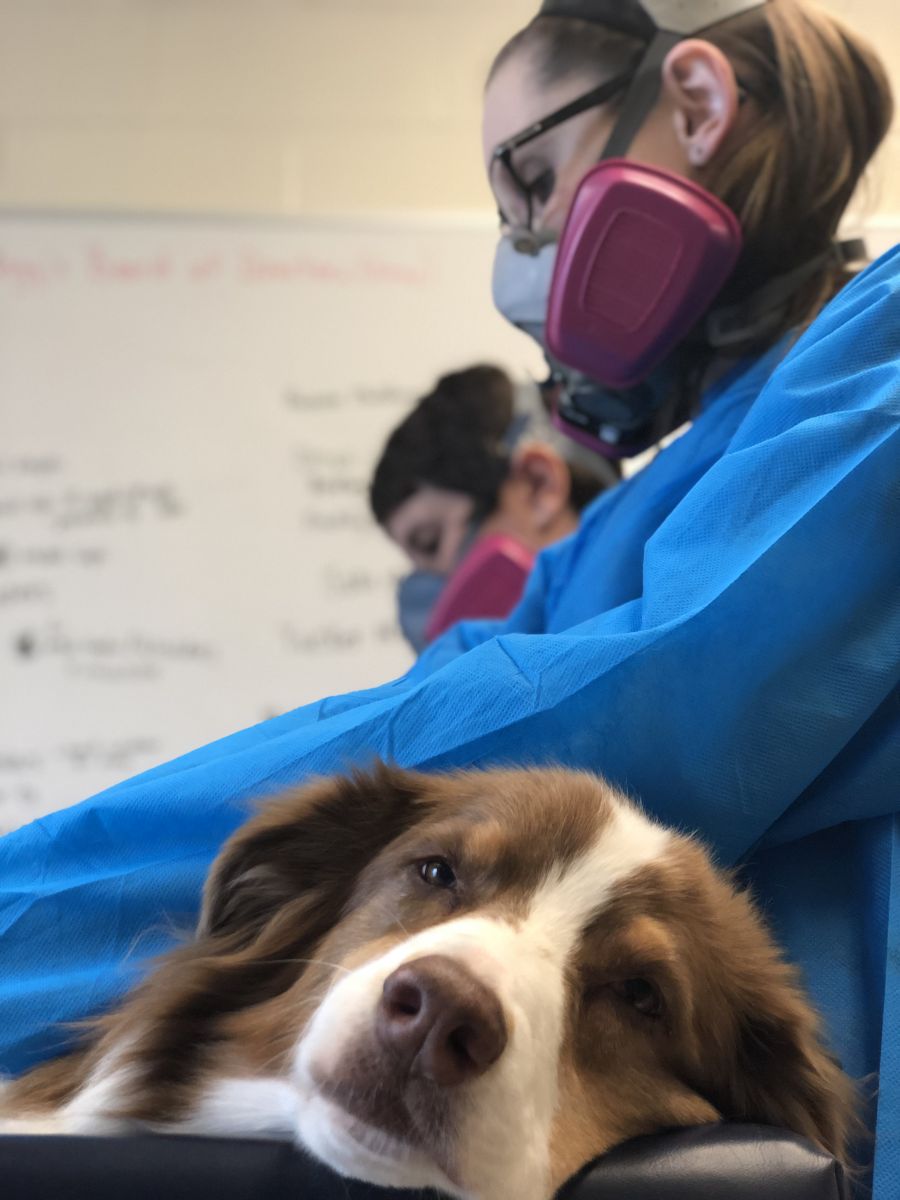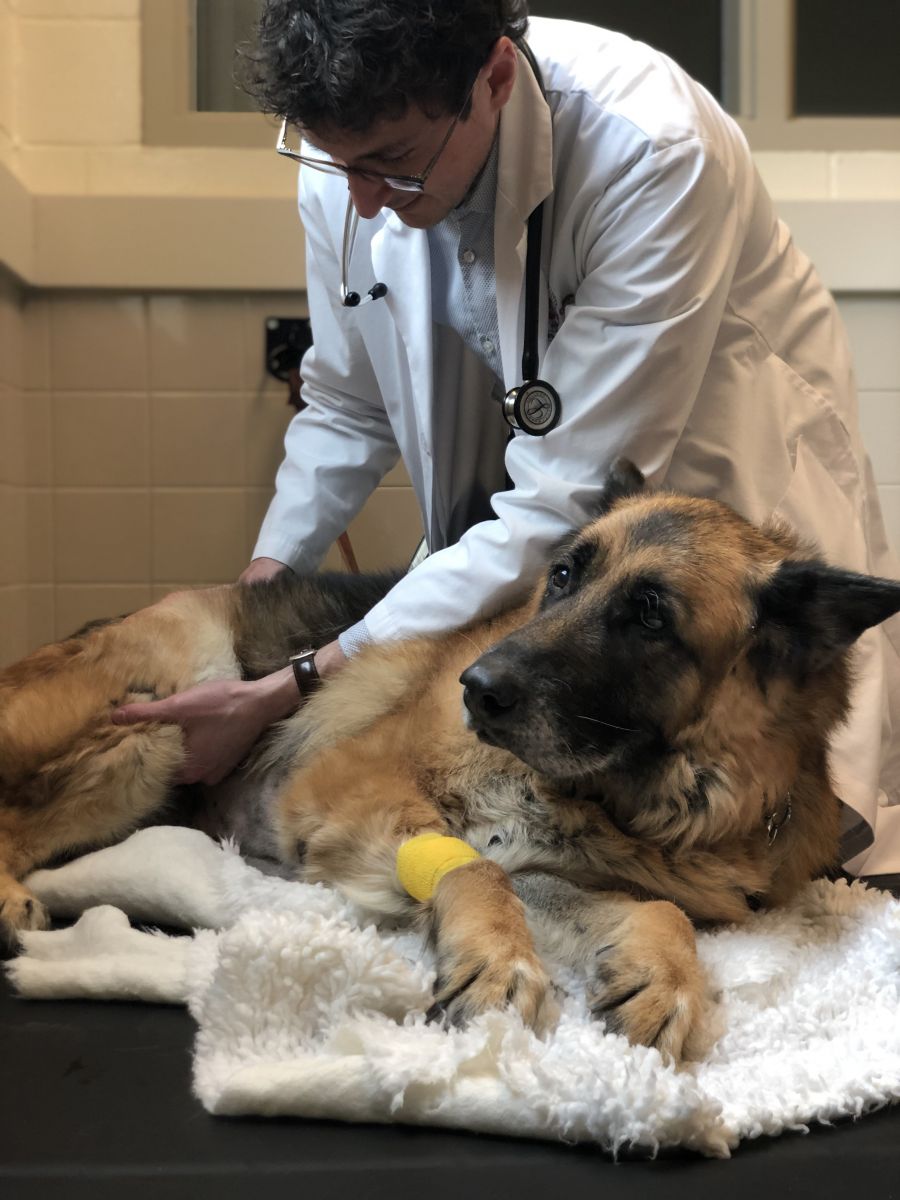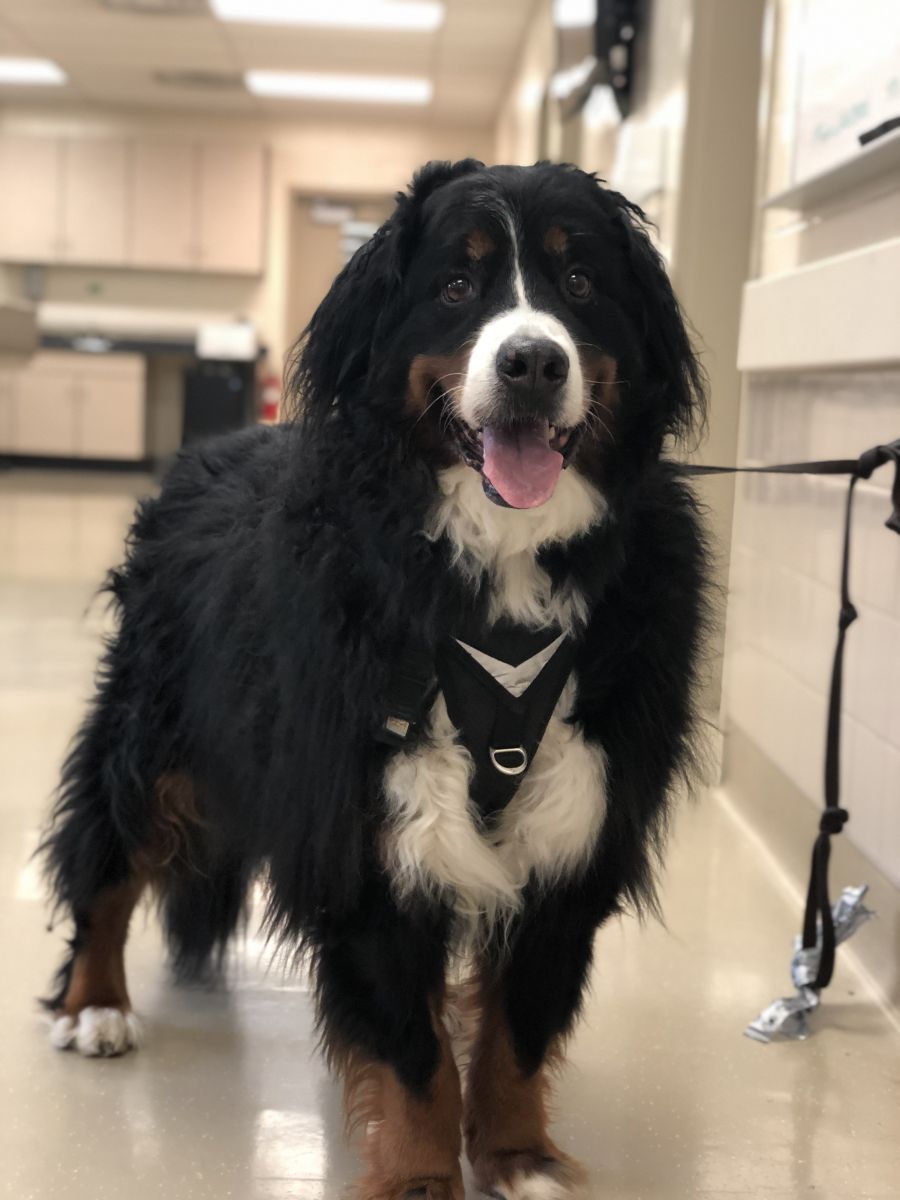
Dr. Chris Pinard (OVC 2016) is a licenced veterinarian who is studying to become a veterinary specialist. He is currently pursuing a three-year Doctor of Veterinary Science (DVSc) degree and simultaneously pursuing a clinical residency training program in medical oncology – a branch of medicine that deals with the diagnosis and treatment of cancer in pets. His advanced specialty training includes both clinical duties and research work.
Today he is on clinics at the Mona Campbell Centre for Animal Cancer in the OVC Health Sciences Centre, a specialty referral hospital and the first comprehensive centre of its kind in Canada, helping pets and their owners. Each day on clinics Pinard diagnoses, treats and fights alongside his patients in their own respective battles with cancer. Every year the centre has more than 5,000 patient visits, with owners traveling with their pets to Guelph from across Canada and from around the world to receive advanced cancer care. Our writer went behind-the-scenes with Pinard and his team to get a glimpse into the hopeful and compassionate world of veterinary medical oncology.
MORNING
Today, before patients arrive at the University of Guelph’s Ontario Veterinary College (OVC), the medical oncology team meets for journal club. The goal of this weekly session is to bring newly-published research – the latest knowledge and innovation in cancer research from around the world – directly to the clinic floor at OVC. Each doctor reviews the findings from their respectively assigned research paper – this morning, Drs. Sarah Laliberté, oncology intern, and Sam Hocker, board-certified medical oncologist, are presenting studies from academic institutions in Italy and the United States.
.jpg)
The team has discussions about the implications and applications of the findings within each paper and review how their current or future patients may benefit or be impacted by the literature. Journal club helps trainees and specialists stay up-to-date and at the forefront of cancer treatments; it is also an important requirement within the board certification process and a key component in Pinard’s training to become a medical oncology specialist.
OVC’s oncology team is made up of faculty and veterinary specialists; residents and interns; a surgical oncologist; a radiation oncologist; registered veterinary technicians (RVTs); and a clinical counsellor.
The centre is also home to the Companion Animal Tumour Sample Bank, a unique resource that houses thousands of cancer tumour and blood samples that are available to the scientific community for future cancer research. When Pinard talks to pet owners, he explains the various team members, who, even though they may not meet personally, are all operating behind-the-scenes.
“Cancer can be a scary subject,” says Pinard. “I believe it is important to explain what cancer care looks like at OVC and in veterinary medicine. It is our responsibility to explain the combined expertise and collaborative approach, all aimed to deliver the best possible care for every pet that comes through our doors.”
After journal club, the team rounds at the central white board, reviewing all patients’ history and treatment plans before the day gets underway. Today, twenty patients in total, mostly dogs and one cat, are scheduled to visit the cancer centre, a pretty typical day. Some patients are in remission; others have relapsed or taken a turn for the worst.
This morning, Chris will see three new patients who are visiting the cancer centre for the very first time and check in with six returning patients who are here for their chemotherapy treatments. His patients are battling different types of cancer with varying prognoses, or chances of survival, including lymphoma, mast cell tumours, hemangiosarcoma, osteosarcoma and more.
Morning appointments begin at 9 a.m., with a flurry of dogs arriving to be set up for their treatments. RVTs bring dogs Radar, Cassie and Bailey into the treatment room, and like all patients who are visiting the cancer centre, they will undergo pre-treatment physical exams as well as spend a short time after their therapies under the supervision of the veterinary team.
.jpg) As Pinard performs a physical exam on Radar, an eight-year-old Australian Shepherd with lymphoma who is here for his chemotherapy treatment, he explains the importance of thoroughly examining each patient prior to their treatment. “Depending on the cancer type, a physical examination can tell us how a patient is responding to chemotherapy; this is especially true in dogs with lymphoma. In others, it is vital that they maintain their health and quality of life through this process.”
As Pinard performs a physical exam on Radar, an eight-year-old Australian Shepherd with lymphoma who is here for his chemotherapy treatment, he explains the importance of thoroughly examining each patient prior to their treatment. “Depending on the cancer type, a physical examination can tell us how a patient is responding to chemotherapy; this is especially true in dogs with lymphoma. In others, it is vital that they maintain their health and quality of life through this process.”
Pinard and his team are gifted communicators. “My goal is to make sure our patient’s families have all the information they need to make an educated and informed decision for their pet. For many patients, there is a lot we can offer that will help maintain a very good quality of life,” Pinard explains. “I want our clients to understand the gold standard of care that is available to their pet here at OVC.”

In consultation with the team of board-certified specialists, Pinard acts as a guide for his patients: that may mean navigating the road to a definitive diagnosis of what the pet is facing; developing a personalized treatment plan; and explaining all of the risks, benefits and considerations that come along with battling a life-altering disease. In the end, some owners decide to pursue all of Pinard’s recommendations. Others, for many reasons, may choose not to.
Some of the questions pet owners have when they learn their pet has cancer are: “How long does my pet have to live?”and “What would you do if it was your pet?” Pinard draws from his own experiences and what originally inspired him to study the field of veterinary oncology: in his second year of veterinary school, he lost his beloved dog, Jude, to a nasal tumour. Pinard very openly explains to his clients there is no right or wrong when it comes to making their decision, keeping quality of life for their pet, financial, emotional and personal factors in mind. Through this morning’s appointments, he constantly reminds owners that their quality of life matters as well as that of their pet. “We know that these amazing families want the best for the pet they love. It is our job to offer everything that is medically and reasonably available for that patient to help an animal fight cancer and help owners make the decision that is best for them – sometimes this may involve treatment or other times it may not,” Pinard says.
AFTERNOON
Frank, an eight-year-old Bernese Mountain Dog, greets Pinard in the waiting room. Frank is a new patient and has a suspected soft tissue sarcoma, a broad term for cancers that start in the muscle, nerves and other connective tissues. As like with all new patients who come to the animal cancer centre, he has been referred by his family veterinarian. Three returning dog patients – Zinfandal, Molly and Zimba have also arrived for their chemotherapy appointments. Much like the morning, there is a whirlwind of activity. Team members meet with pet owners to find out how patients are doing back at home between therapy sessions. Pinard conducts their physical exams and blood samples are collected. Once test results arrive back from the Animal Health Lab, if the bloodwork shows that their white, red and clotting cell (platelets) counts are within normal range, he authorizes scheduled therapies.

“In veterinary oncology, our ultimate goal is to increase the quality of life for each individual patient,” Pinard explains.
 Depending on the type and severity of cancer, treatment options may include surgery, chemotherapy, radiation therapy or a combination thereof. Frank’s owners decide to do anything and everything they can to help their dog battle his cancer diagnosis. Next steps for Frank will involve scheduling diagnostic imaging tests later in the week to get a clear picture of how far or even if the cancer has spread in his body before targeted treatment can begin.
Depending on the type and severity of cancer, treatment options may include surgery, chemotherapy, radiation therapy or a combination thereof. Frank’s owners decide to do anything and everything they can to help their dog battle his cancer diagnosis. Next steps for Frank will involve scheduling diagnostic imaging tests later in the week to get a clear picture of how far or even if the cancer has spread in his body before targeted treatment can begin.
Once all new patients have been treated for the day, rounds begin again for the entire team. Afternoon rounds involve each intern, resident and specialist summarizing their day for all of the patients they have met or treated.
EVENING
.jpg) While each day is different, after all of his patients have gone home or if any have been transferred to OVC’s intensive care unit (ICU) for the evening for around-the-clock monitoring, it’s time for paperwork, phone calls and scheduling. A typical evening for Pinard involves completing patient medical records; phone calls to owners and referring veterinarians to provide updates; and finding the next available day and time to schedule tests, procedures and therapies for his patients.
While each day is different, after all of his patients have gone home or if any have been transferred to OVC’s intensive care unit (ICU) for the evening for around-the-clock monitoring, it’s time for paperwork, phone calls and scheduling. A typical evening for Pinard involves completing patient medical records; phone calls to owners and referring veterinarians to provide updates; and finding the next available day and time to schedule tests, procedures and therapies for his patients.
The days can be long, but Pinard is grateful for the opportunity to train at a world-class veterinary school and expand his knowledge in the field he’s so passionate about. “The more I learn, the more I can help my patients. At the end of the day, that’s what I am here for. It’s a great feeling to learn from and be part of such an amazing team.”
Read more in the spring / summer issue of Best Friends Magazine.

